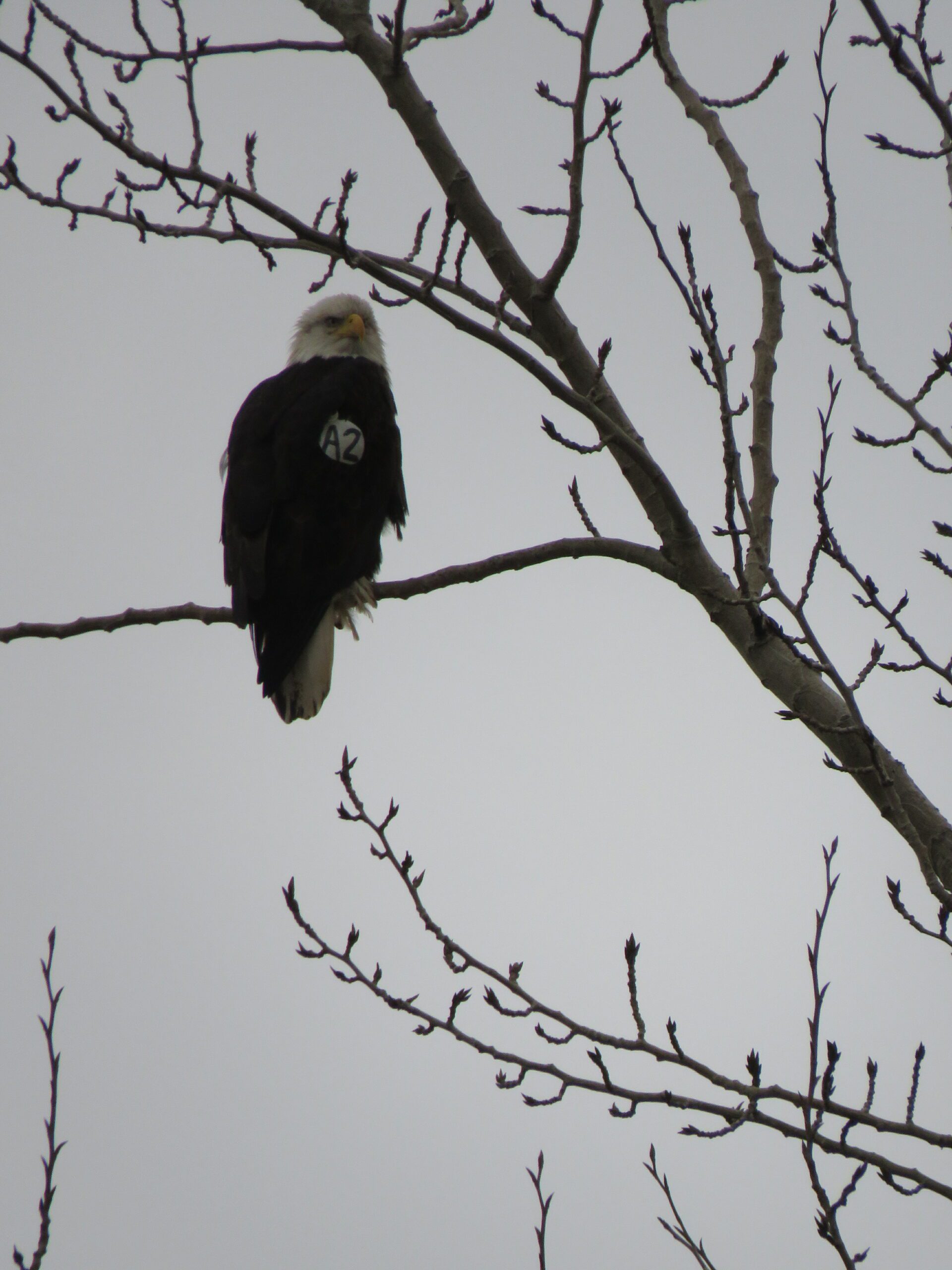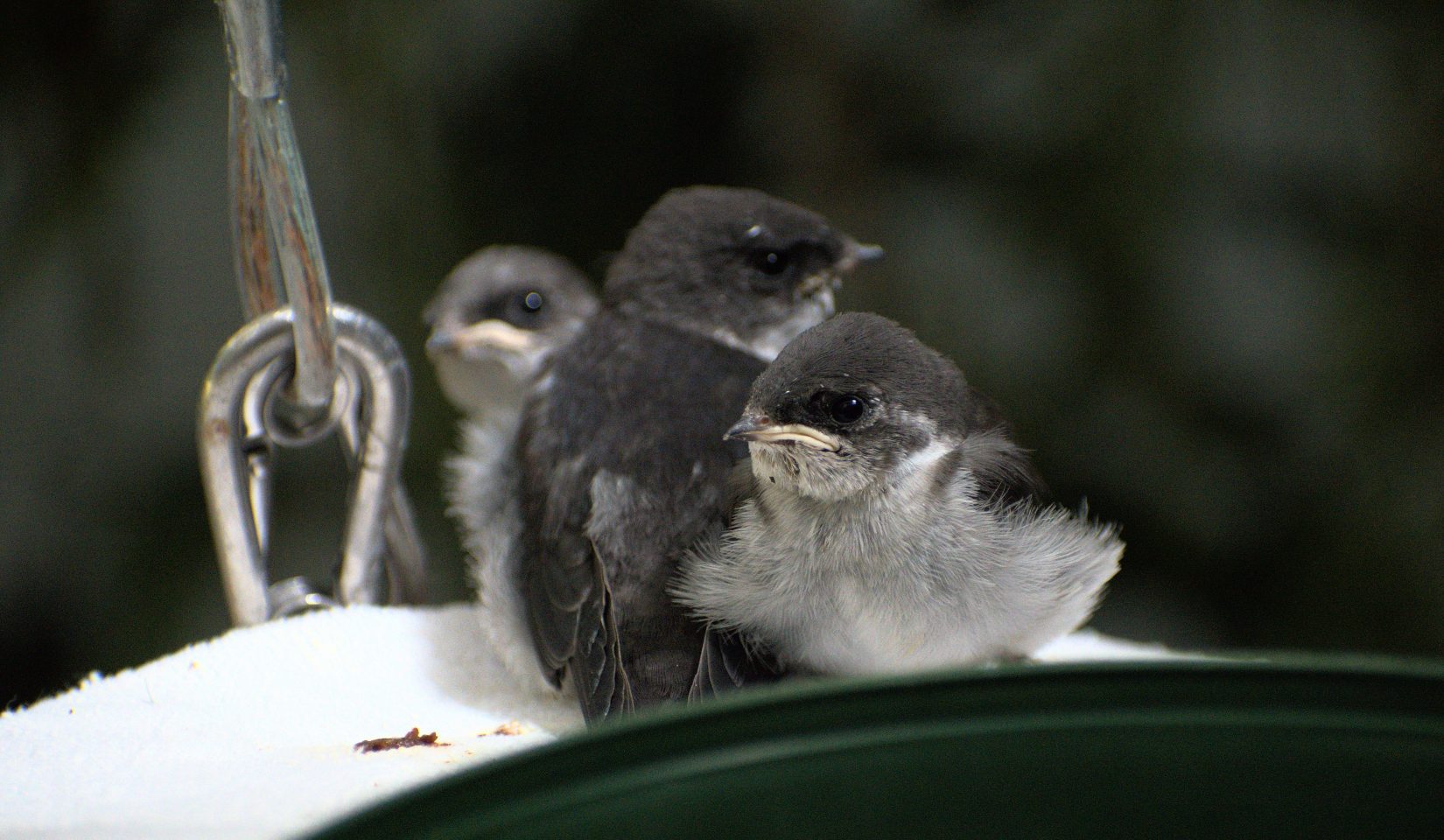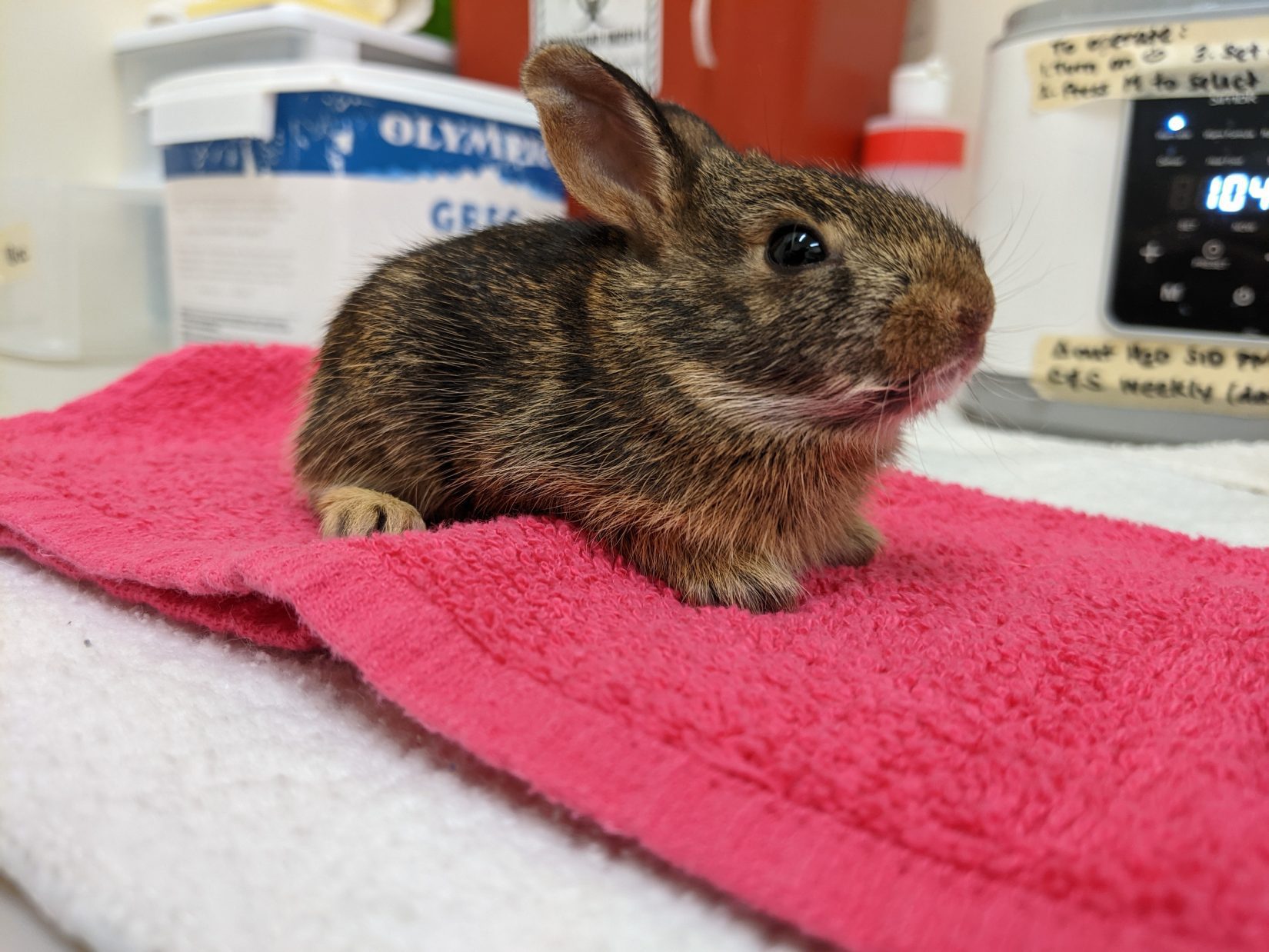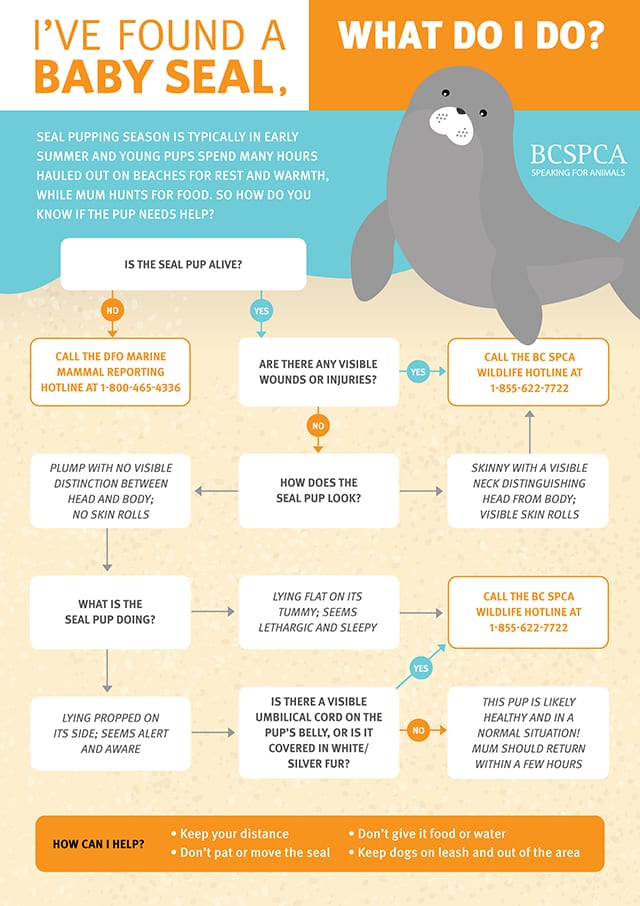I found a...
Whether it’s a baby bird, squirrel, deer, seal, raccoon or skunk, a baby animal’s best chance for survival is with its mother. Finding a baby animal doesn’t always mean they’re in trouble – many times, you won’t need to do anything at all. However, if the baby is hurt or sick, or you know the mother is dead, they will need help right away.
Learn more about what to do if you have…
If you have found a baby wild animal and you don’t know what to do, contact your local wildlife rehabilitation centre or call our Animal Helpline at 1-855-622-7722 for advice. They can advise you on how to tell when they need help or how to return the baby safely.
Can I touch a baby animal?
Birds have a poor sense of smell and will not reject babies touched by people. This means you may be able to place baby birds back in their nest. Mammals have a much more keen sense of smell, however, they are also very dedicated parents. A reunion may still be possible – under the guidance of a wildlife rehabilitator – even when babies have been handled by people.
Before handling any animals, call your local wildlife rehabilitation centre or our Animal Helpline at 1-855-622-7722 for advice on how to reunite baby animals with their mothers.
Should I feed a baby animal?
Never attempt to feed a baby animal, this usually does more harm than good. Wild animals require professional care, and it is illegal for you to keep and care for a wild animal.
Read more about rescuing wild animals.
Want to receive more stories like this, right in your inbox? Subscribe to WildSense, our bi-monthly wildlife newsletter.
A baby bird may be blown out of a nest by wind or rain, or even dropped after a failed predatory attack. If the bird isn’t hurt, you can place it back in the nest. Unlike mammals, birds have a poor sense of smell and will not reject babies touched by people.
Watch the nest for one to two hours to confirm the parents are coming back to feed the baby. If the parents don’t return, or the baby bird is hurt, contact your local wildlife rehabilitation centre or call the BC SPCA Animal Helpline at 1-855-622-7722 for advice. Sometimes parents will reject baby birds if there is something wrong with them, or they are too weak.
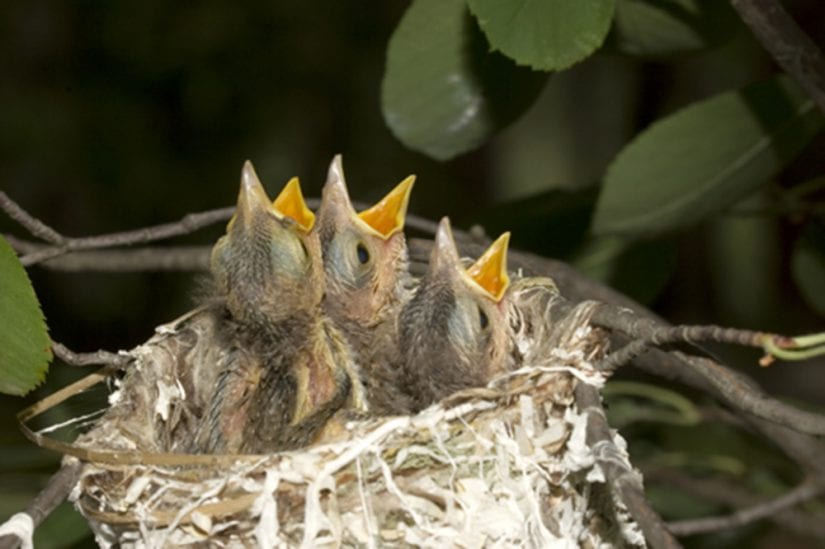
In the spring and summer, you may see healthy-looking birds on the ground that can’t fly. These young birds are called fledglings. Birds at this age are just learning how to fly.
The parent birds are usually close by for protection, but will not feed the fledglings as often. This makes the young birds hungry so they hop out of the nest to explore.
Try to keep the area safe while these birds learn how to fly. Keep cats and dogs inside or on leash, and leave the area undisturbed.
If the birds are in an unsafe area, like a road or parking lot, call the BC SPCA Animal Helpline for advice at 1-855-622-7722. Read our care sheet found a baby bird (PDF) and find out more about what to do if you find a baby bird.
Read more about rescuing wild animals.
Gulls
Gulls often nest on the flat roofs of commercial or apartment buildings. Most times, the young gulls will fly off with their parents when they are ready. As the young gulls are learning to fly, sometimes they jump or tumble from the roof before they are able to fly well. When this happens, they often land in an unsafe location and are unable to fly to safety.
If a young gull is stuck in an area without food for more than a day, and you do not see adult gulls coming down to bring food to the baby, it might need to be rescued. In this case, contact your local wildlife rehabilitation centre or call the BC SPCA Animal Helpline for advice at 1-855-622-7722.
Read more about rescuing wild animals.
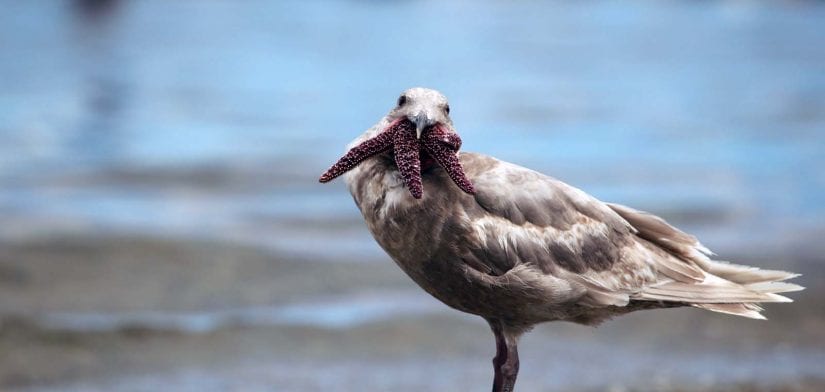

Every year, wildlife rehabilitators care for healthy fawns that were thought to be orphaned. It is normal for a mother deer to leave a fawn alone for periods of time. They come back only a few times a day to feed the baby, who waits quietly while hiding from predators.
If you find a fawn lying quietly, and you are worried they have been abandoned, don’t disturb them. Check on the fawn from a distance for the next 24 hours – the mother will likely return and move the baby to a new spot.
If the fawn has not moved after 24 hours, starts to cry, is wandering aimlessly, or looks injured, contact a wildlife rehabilitator right away.
If the fawn is in an unsafe location, move them gently to a safe spot very close by so they won’t get hurt.
Print our card on what to do if you find a deer fawn (PDF).
Read more about rescuing wild animals.
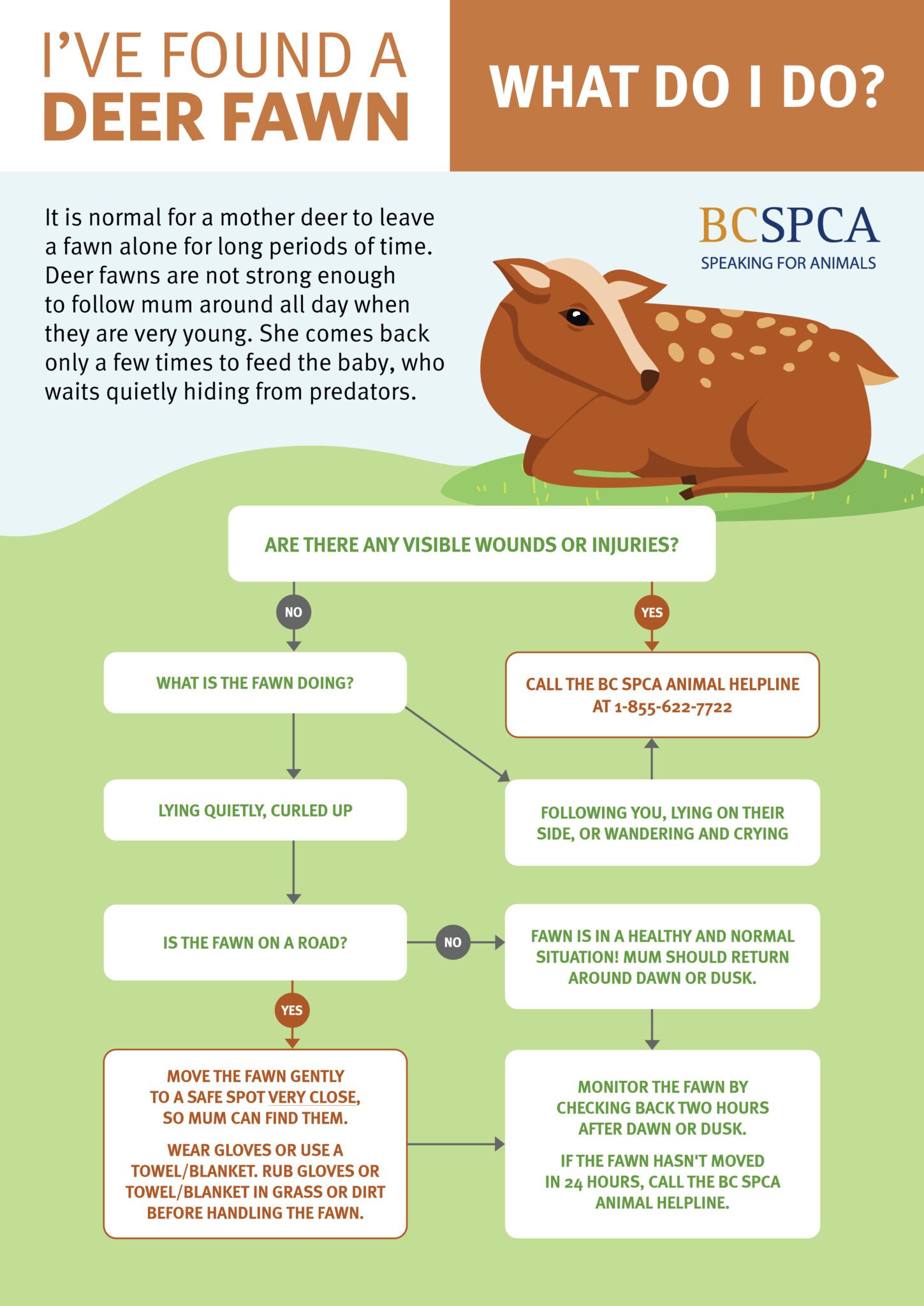
Wild eastern cottontail rabbits nest in shallow depressions in grassy areas, which make baby rabbits vulnerable to lawn-mowers, dogs and free-roaming cats. Baby rabbits found alone don’t always need help – it’s normal for a mother rabbit to leave her babies alone and hidden in the nest for long periods of time. She will typically come back only a few times a day to feed the babies who wait quietly while hiding from predators.
Not sure if they’re a wild rabbit or a domestic feral rabbit? Learn more about telling the species apart or take a picture and call your local wildlife rehabilitation centre or the BC SPCA Animal Helpline at 1-855-622-7722 for advice.
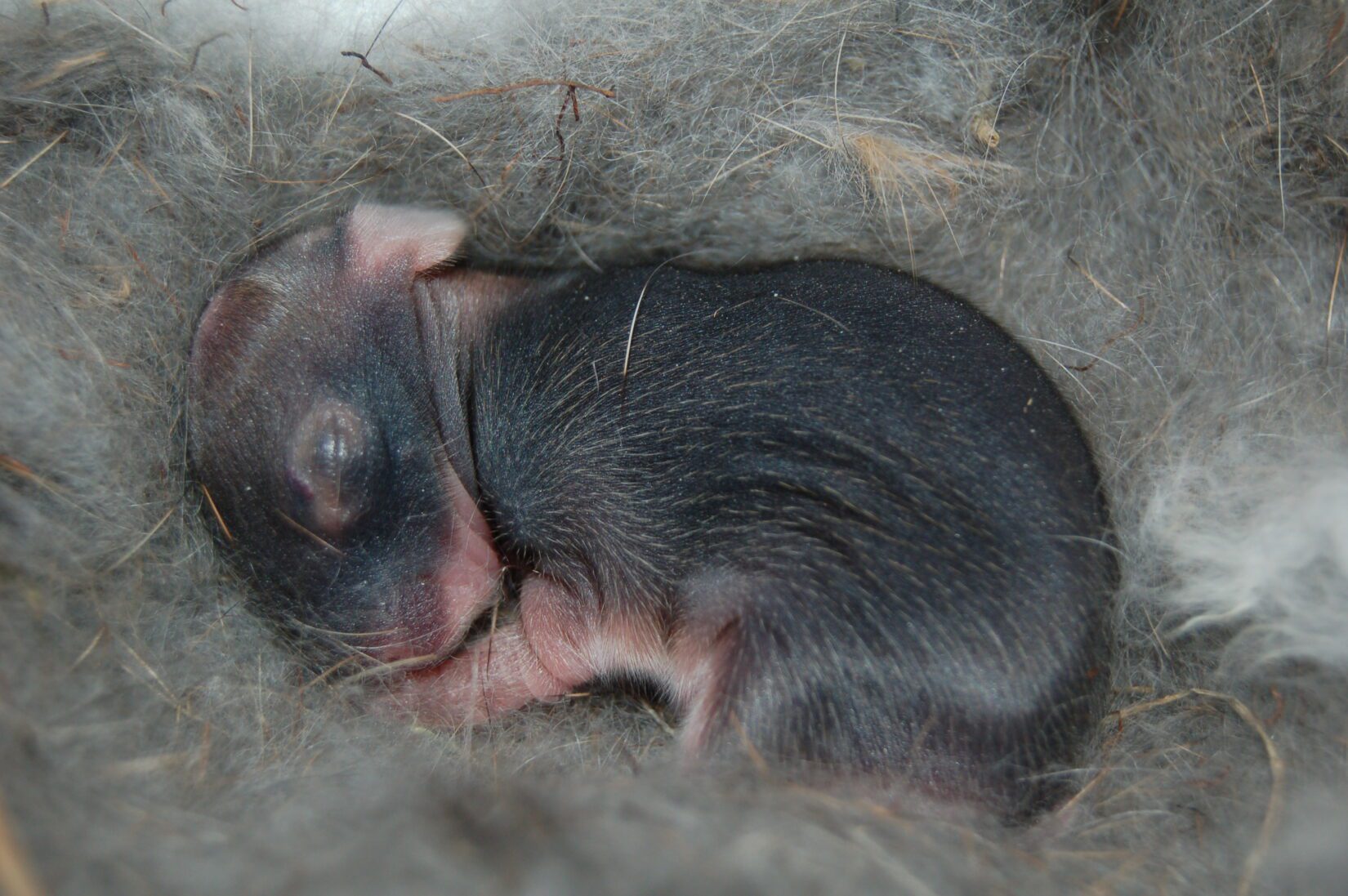
Eastern cottontails are born pink and hairless, but develop dark fur very early. They have stubby noses, large ears relative to the size of their head, and their ears lay flat against their body. They have short tails (less than half body length), and front legs shorter than their back legs. All this combined gives eastern cottontail babies the appearance of a “baby hippo”.
A baby rabbit will need help if they:
- have obvious signs of injury (blood, wounds etc.)
- have been caught by a cat or dog
- are orphaned (do a parent test to confirm)
For minor disturbances, babies too young to be on their own can be placed back in the nest with the original nesting material – do a parent test to check that mom has returned. With parental care confirmed, it will only take a couple of weeks for the babies to grow up enough to leave the nest. Keep pets away and hold off on any more yard work until this time. If you’re unsure if they need help, or the babies (and any adults) are obviously injured (e.g., bleeding, broken limbs), call your local wildlife rehabilitation centre or the BC SPCA Animal Helpline at 1-855-622-7722 for advice.
Young eastern cottontails may appear very small, but they’re ready to be on their own very quickly!
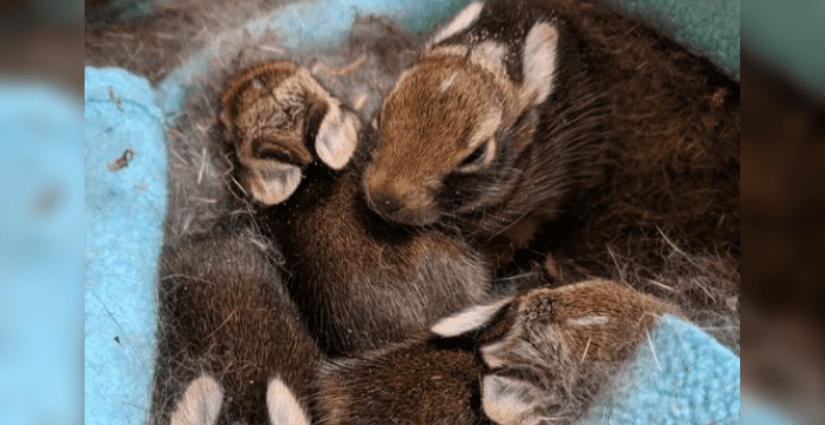
These rabbits are very close to being able to survive on their own but are still too young to be without a returning parent – their pinned back ears and long bodies are tell-tale signs they still need to be cared for.
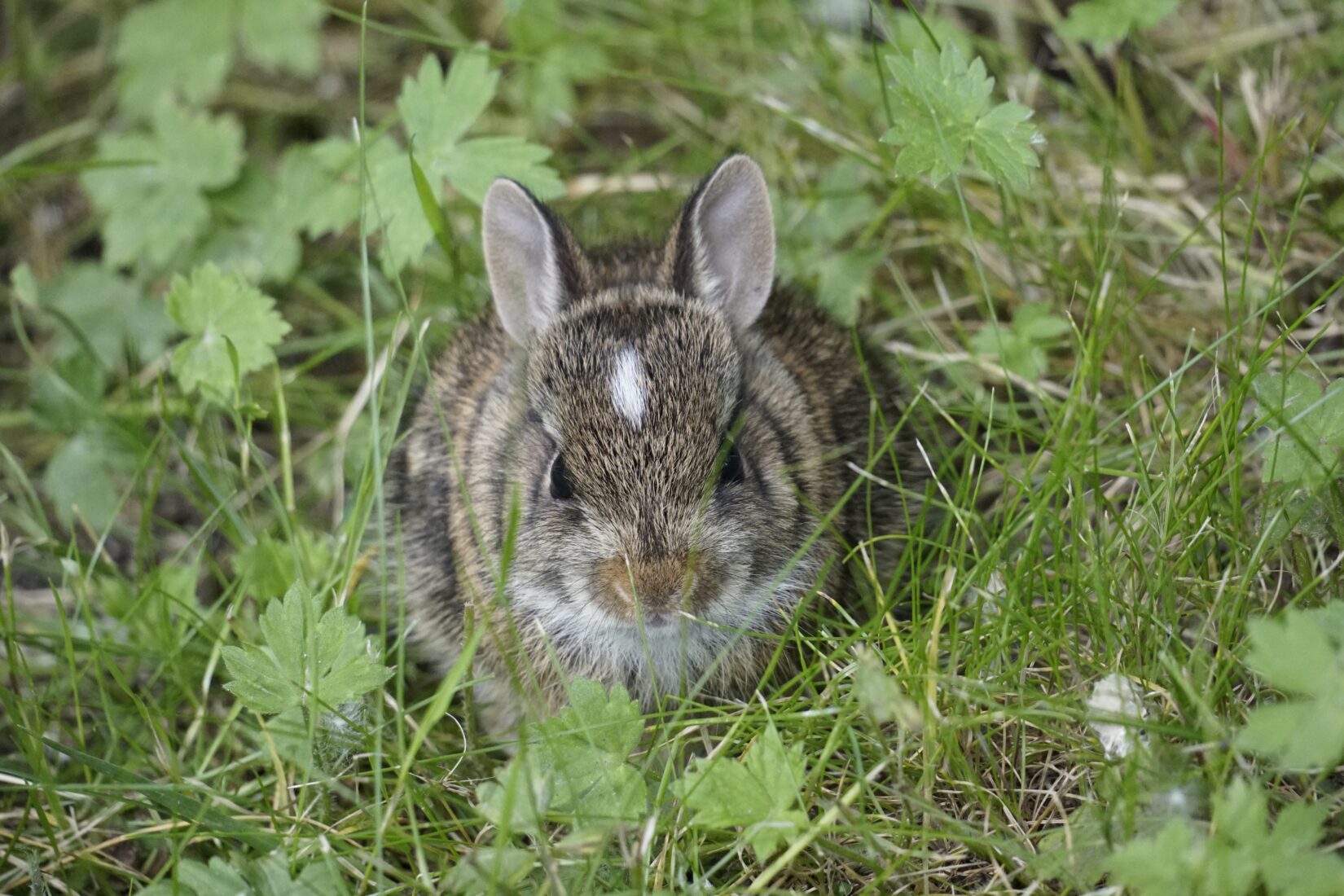
This young rabbit is fine to be on their own – their ears are up and alert and their body is round and shaped like a tennis ball.
To find out if a baby rabbit is truly orphaned, do a parent test.
Steps to do a parent test:
- Place pieces of long grass or thin twigs in a grid (tic-tac-toe) over the nest – use natural material rather than synthetic, and do not use heavier materials as the mother rabbit is unlikely to move them during her brief and delicate visits.
- Don’t add anything extra like food or coverings – because rabbits are prey species, new scents may scare the mom from returning, and supplemental food is not necessary and could upset their delicate systems.
- Take a photo of the nest with the grid in place.
- Wait 24 hours.
- Take another photo of the grid and compare it to the first.
- If the grid has been disturbed, the mom has come back to care for her babies. If the grid has not changed, the babies may need to go to a wildlife rehabilitator.
If you are having trouble assessing before and after photos when conducting a parent test, get in touch with your local wildlife rehabilitation centre or call the BC SPCA Animal Helpline for help at 1-855-622-7722.
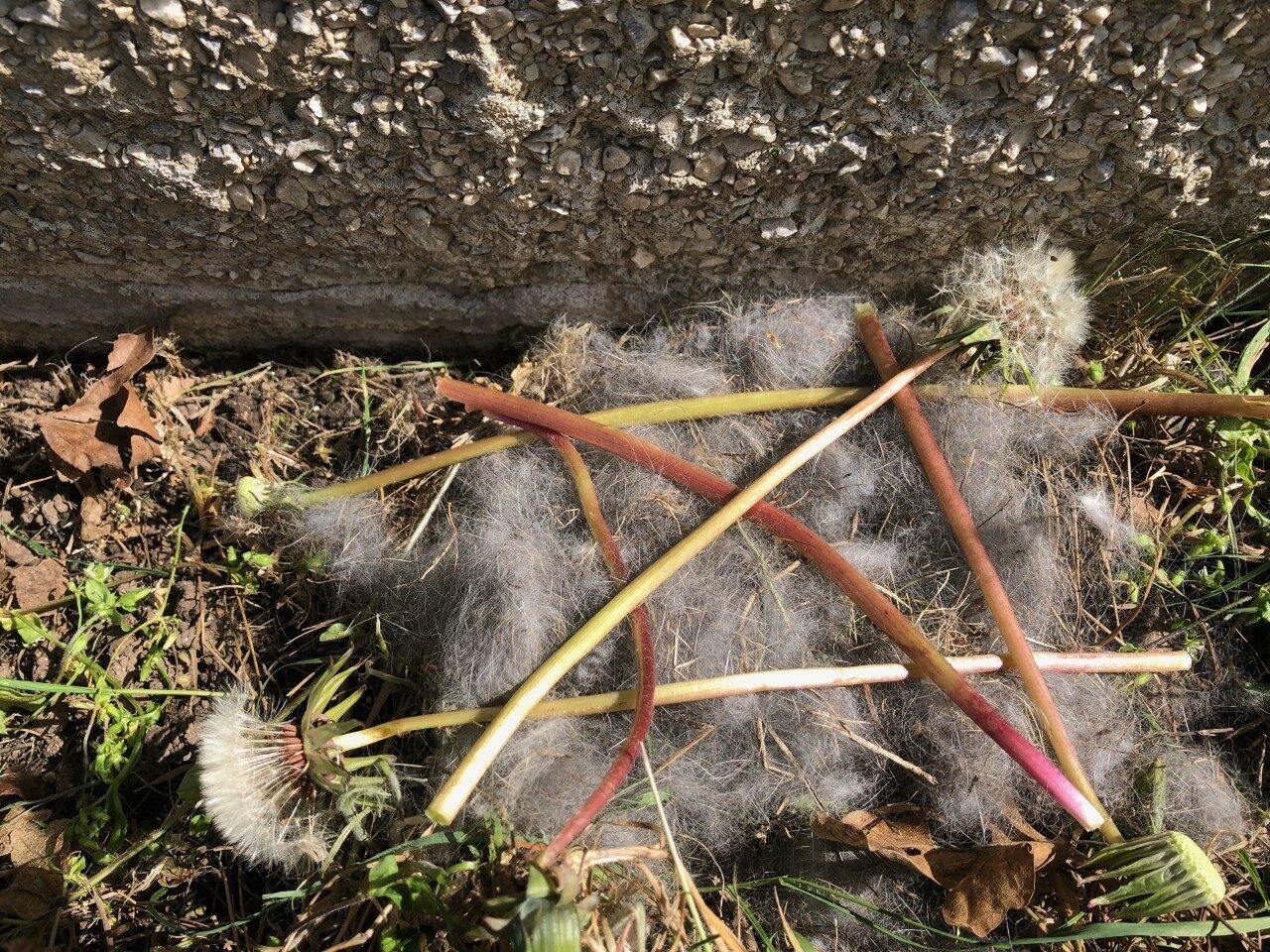
Read more about rescuing wild animals.
A mother seal will leave her pup on a beach or rocks near the water while she hunts for food. A seal pup alone is not always an orphan. Healthy seal pups look plump with no skin rolls, and seem alert and aware.
Keep dogs on leash and away from the seal pup. Also, discourage people from approaching – although baby seals are very cute, this is very stressful for them as we appear as predators.
If the seal pup is injured, looks skinny or lethargic and sleepy, contact Marine Mammal Rescue Centre (MMR) at 1-604-258-7325 or call our Animal Helpline for advice at 1-855-622-7722.
Find out more about what to do if you see a baby seal or download our brochure “What to do if you find a baby seal” (PDF). Read more about rescuing wild animals.
Bats are the only wild carrier of rabies in B.C. and should never be touched or directly handled. Rabies can spread through just a drop of a bat’s saliva. Vaccinate your pet to protect them from contracting rabies.
If a bat has had any skin contact with a person, the bat must be euthanized and tested for rabies. If a bat has had contact with a pet, the bat may be sent for rabies testing. Contact your doctor, veterinarian or local public health authority immediately in cases of contact with a bat. Learn more about rabies transmission.
Bat populations are in decline, and injured bats can be rehabilitated. Call your local wildlife rehabilitator or our Animal Helpline at 1-855-622-7722 for advice on safely containing bats.
Help bats by also watching out for signs of White-Nose Syndrome (WNS). White-Nose Syndrome is a fungal disease that has been devastating bat populations across North America. The fungus grows on the nose and bodies of infected bats during hibernation and causes them to wake and use valuable energy at a time when they should be conserving it. White-Nose Syndrome has not been observed in B.C. yet, but the fungus that causes it was detected in the Grand Forks area in 2023.
Between November 1 and May 31, White-Nose Syndrome can be detected on dead bats if they are infected. Help detect White-Nose Syndrome by reporting dead bats and unusual winter bat activity to the BC Community Bat Program at 1-855-9BC-BATS (922-2287) or by email at info@bcbats.ca.
To learn more about coexisting with bats, read the BC SPCA’s best practices for bats.

Don’t try to take care of injured or orphaned wildlife yourself – it is illegal and can cause harm. Contact your local wildlife rehabilitation centre or call the BC SPCA Animal Helpline at 1-855-622-7722 (1-855-6BC-SPCA) for advice on wildlife situations.
Except for Wild ARC, BC SPCA branches do not rehabilitate wildlife. A local veterinarian may be able to help euthanize a suffering animal, but they do not have the permits or facilities to provide full rehabilitation services. Call your local RCMP or Conservation Officer Service if you see adult deer/elk/moose/bears injured on roads.
Read more about how to rescue wild animals.
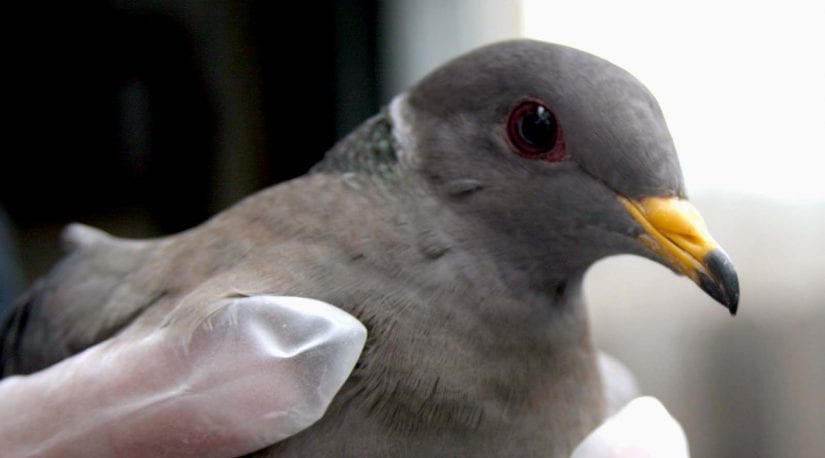
Small deceased wild animals found on private property can be buried or bagged and put in the garbage. Do not touch dead wildlife with your bare hands – use disposable gloves or a tool – and never put a dead animal in compost or green bins. For larger animals on private property, it may be your responsibility to dispose of them, and you may need to contact a waste removal company for help. Contact your local municipality for more information.
For deceased animals found on public land, contact your local animal control or public works office for removal.
If there is more than one deceased animal in the same area, or if you suspect disease, consult the provincial government website for reporting instructions for a variety of species including amphibians, bats, birds, small mammals, large mammals, and marine mammals.
Dead bird reporting
Birds are susceptible to diseases such as West Nile virus and avian influenza. To monitor bird health in British Columbia, reports of sick and dead wild birds are of interest to federal and provincial government agencies. The B.C. Wild Bird Mortality Investigation Protocol & Avian Influenza Surveillance Program coordinates the surveillance of diseases and deaths throughout the province.
Report sightings of dead wild birds by reading the Wild Bird Mortality & Avian Influenza Surveillance Program (PDF) information sheet and calling 1-866-431-BIRD (2473).
Sick or injured birds should be taken to a permitted wildlife rehabilitation centre as soon as possible. Read more about how to rescue a wild animal. Still need help? Contact your local wildlife rehabilitation centre or the BC SPCA Animal Helpline at 1-855-622-7722 for advice about how to help sick or injured birds.
Learn more about HPAI and ways to reduce transmission in your own backyard.
Bird bands
If you find a dead bird with a band or coloured markers, record the letters and numbers and contact the Wild Bird Mortality & Avian Influenza Surveillance Program at 1-866-431-BIRD (2473).
The North American Bird Banding Program collects information on the distribution and movement of species to help wildlife scientists monitor and conserve migratory bird populations. You can contribute by also reporting the band number online at reportband.gov or by calling 1-800-327-BAND (2263) toll-free to leave a message.
Pigeons are not banded as part of the North American Bird Banding Program. A pigeon with a leg band is likely a domestic pigeon and their band will have letters representing a racing association who can help to get in touch with the owner. Learn more about bird banding.
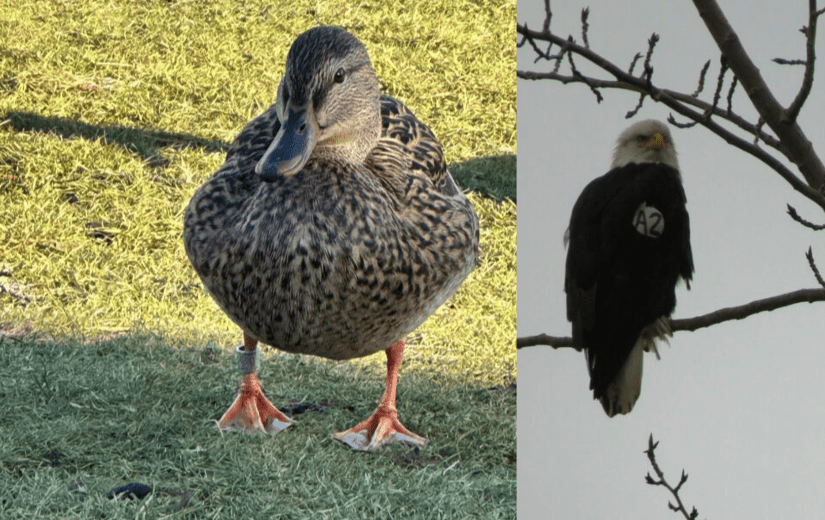
If you spot a bird with a metal band or coloured markers, it’s no accident. The North American Bird Banding Program is jointly administered by the Canadian Wildlife Service and U.S. Geological Survey (USGS). More than 1.2 million birds are banded in Canada and the U.S. each year! When banded birds are seen days, weeks, months or even years later, this data helps wildlife scientists monitor and conserve migratory bird populations by providing information on the distribution and movement of species.
Your contribution is important – the program relies on the public to report bands and other markers they see. You can help by reporting birds online at reportband.gov or call toll-free 1-800-327-BAND (2263) to leave a message.
Taking a photo can help you to read the band numbers, but don’t try to chase or catch wild birds just to read a band. It may take a few sightings to get the complete band number.
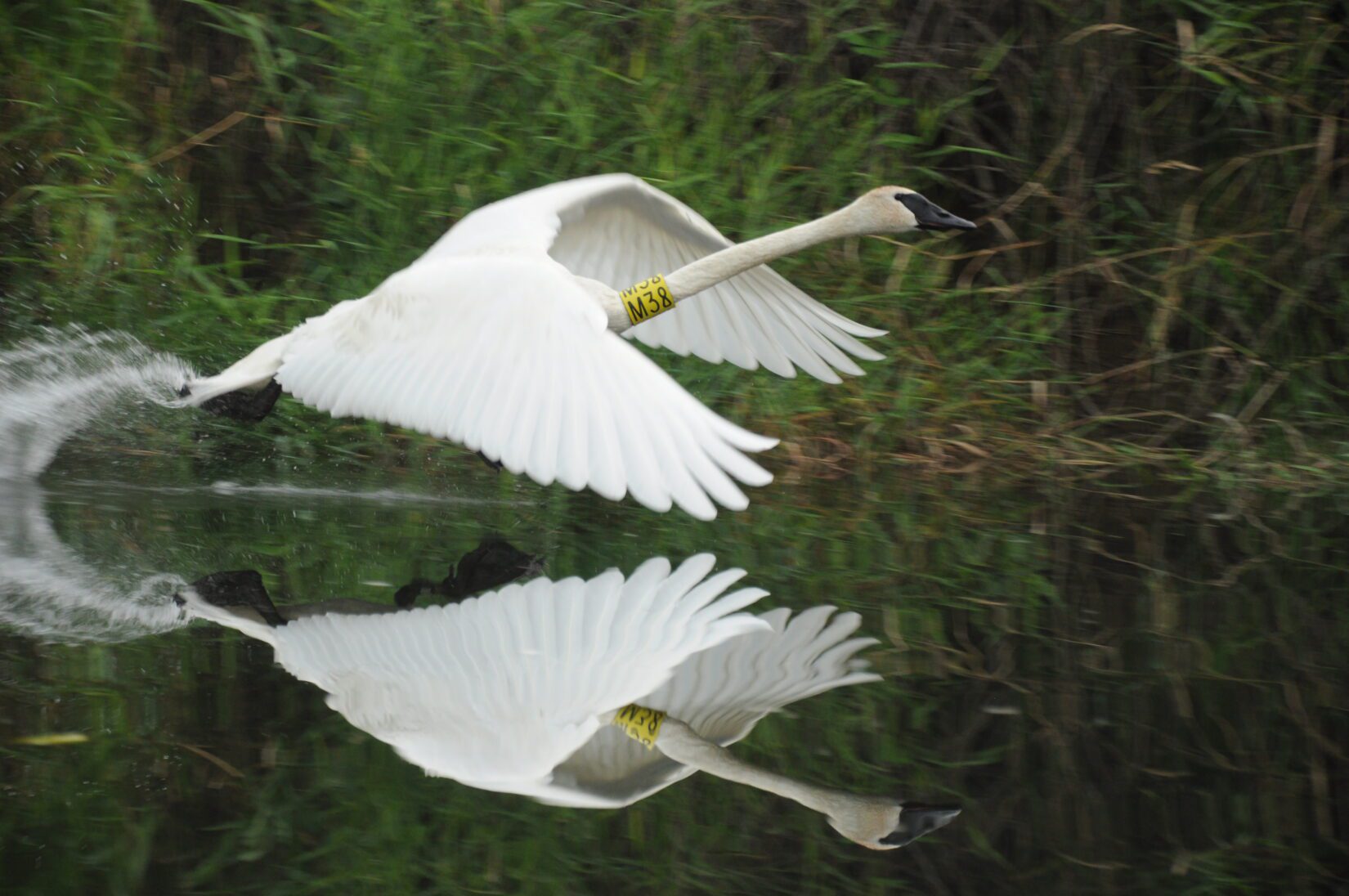
After your information has been submitted, a certificate of appreciation including the bird’s banding information will be emailed to you. The program will also let the bird bander know when and where the bird was seen.
Some birds released from Wild ARC are banded as part of this federal program, which means we occasionally get updates on sightings of former patients. While out for a walk, a Wild ARC staff member noticed two mallards sporting silver leg bands. With lots of photos from various angles and a bit of detective work, the pair were confirmed to be former patients who had come to Wild ARC as orphans in the spring of 2022.
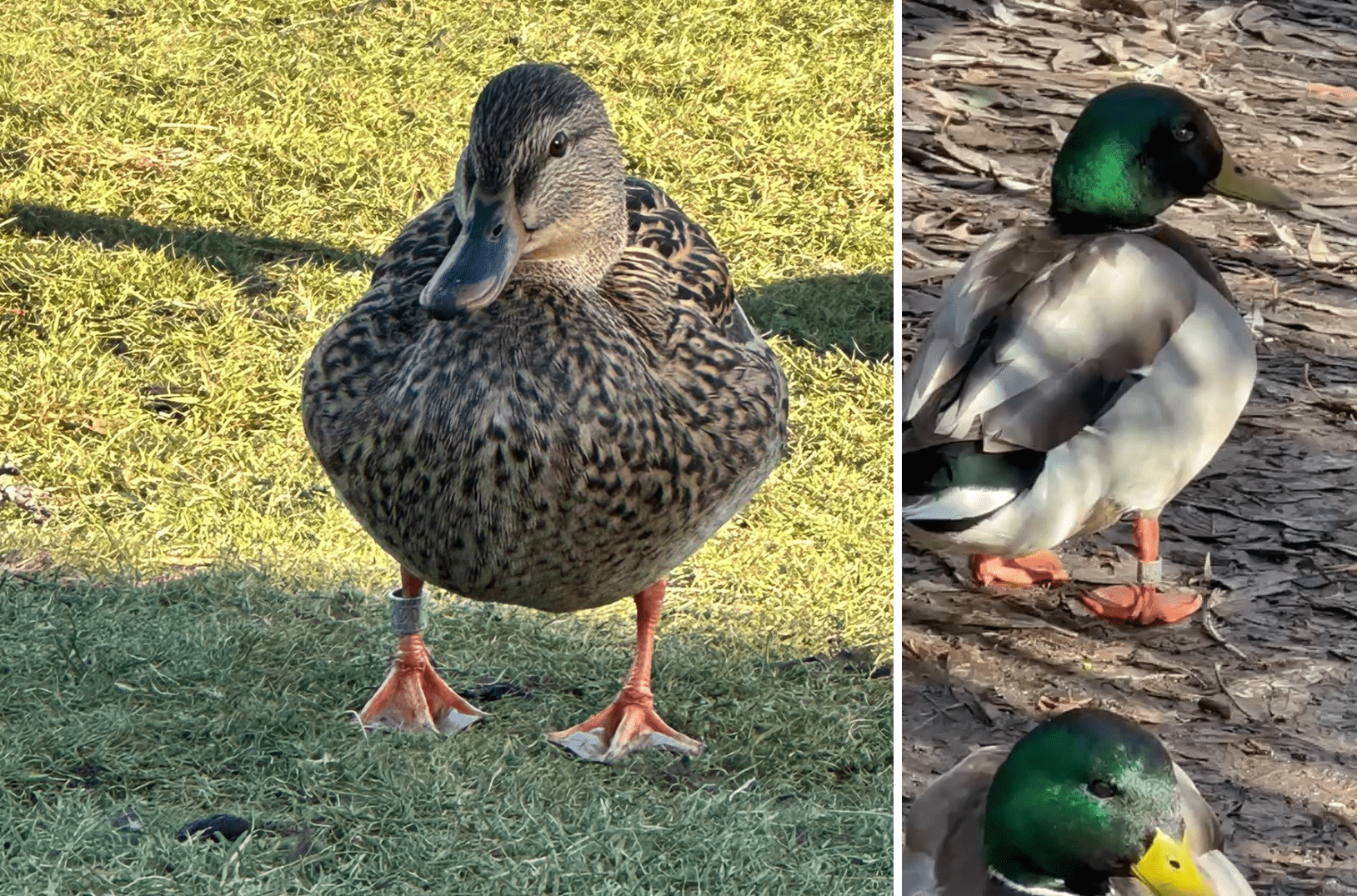
We are always thrilled to see these former patients thriving in the wild with their own kind.
Pigeons are not banded as part of the North American Bird Banding Program. If you find a banded pigeon, they are likely a domestic pigeon that has become lost or tired. Generally, pigeon bands have letters representing a racing association who can help to get in touch with the owner:
Learn more about the North American Bird Banding Program:
